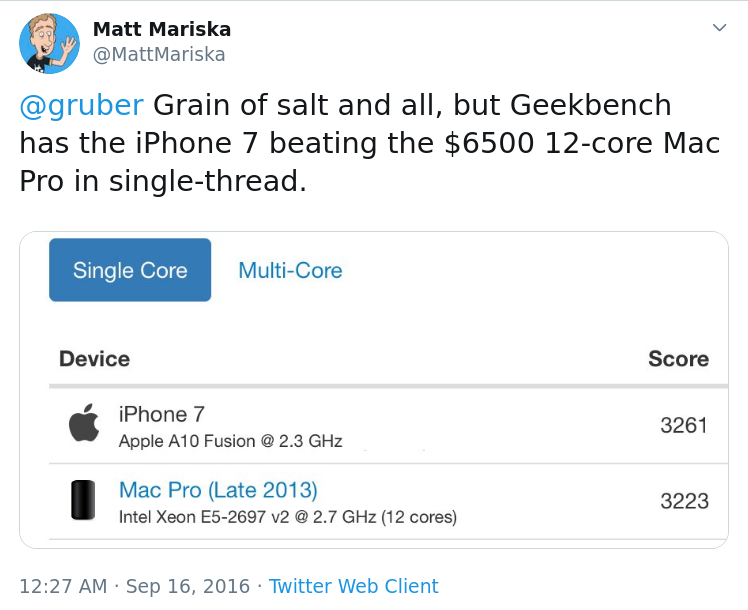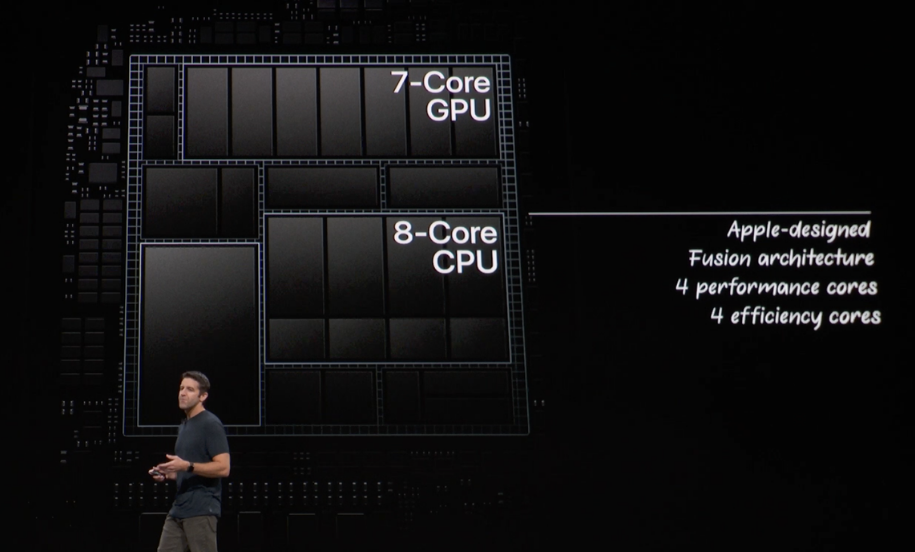
I am sure a very few of you did not like Apple’s announcement in 2005 in its Worldwide Developer Conference to use Intel microprocessors for Macs. Apple’s CEO at that time, Steve Jobs praised Intel’s work and upcoming series of processors. It was an indirect admission of better research work and delivery of microprocessor technology at Intel by late Mr Steve Jobs himself. Intel was equally excited to have Apple Inc as its client. It was nothing but a big step-up for Intel.
Today, it has been over a decade, 13 years to be precise since the transition to Intel from PowerPC architecture. During the time of announcement, Apple had completed a very good decade with PowerPC architecture. It just wanted the best technology for its customers in years come. Immediately after the move there were a few hiccups in the integration of software and hardware. Integration has been Apple’s strong hold owing to less friction to deal with. It has been designing its own chips to optimize its software and deliver the best experience to its customers on Apple hardware.
But why?
Intel’s own CPU architecture, design and delivery related issues
Intel is still good for raw processing power. Isn’t it? Sure. That being so, it has been stuck with 14nm node process since a couple of years. It has recently upgraded to a 10nm node process for a limited number of mobile processors. The processor design limitations are becoming real for Intel. Intel is not able to deliver new technology that it announces in proposed time. It has been either delaying or re-announcing processors with minor upgrades. In fact in the recent years AMD has delivered major upgrades in the manufacturing process. It is not very confusing as to why Apple do not wish to continue with Intel. Apple has closely followed Intel’s difficult move from 14 to 10nm process node. It doesn’t inspire confidence even in me, let alone Apple Inc. It is obvious why Apple is slowly moving to its own ARM-based chips. Although, not directly, Intel has been suggesting the same since last couple of years now. Intel’s CEO, Mr Brian Krzanich gave us a hint back in 2017 when asked about it. Further, in Feb of 2019, a post published by Axios’s Chief Technology Correspondent said, “Although the company has yet to say so publicly, developers and Intel officials have privately told Axios they expect such a move as soon as next year.”
For most consumer electronics, ARM-based processors is the future
These days most of the things are going wireless. There is a need for efficient manufacturing process. A modern consumer is educated about things, thanks to the widespread adoption and availability of mobile Internet devices. People have been following technical blogs and video logs to gain knowledge about specifications of their current and upcoming processors and how it may deliver more computing power while using same or even less battery power than before. This is where ARM-based processors have really come with flying colors.
In fact, Qualcomm has the Snapdragon 8cx, which is its first custom chip for Microsoft Windows ARM computers. It is not just a concept, it is something that you can buy in the stores right away. ARM based PC brings good mileage for frequent business travelers who seek a not so powerful yet portable PC with always-on data connection, better battery life, resume capabilities and instantaneous sleep mode. There are issues like less raw computing power etc but it is more about consumption than computing with ARM as of now. I personally believe, it is just a matter of time. According to AndroidAuthority, Snapdragon’s 8cx is competing furiously with Intel’s quad-core U-series i5-8250U chip in terms of CPU raw power when using standard applications. ARM based 8cx easily substantially beats i5-8250U in GPU. All this, with 60% better battery life and regular benefits that ARM has to offer including always-on modem. It is certainly interesting and exciting at the same time.
Apple’s custom ARM-based A-series processors are phenomenally good both in CPU and GPU performance
Ever since the release of iPhone 7, Apple’s exception development in core architecture and manufacturing process node of mobile A-series chips have been hailed by most analysts and pro users worldwide. In fact, people tweeted about it in a fun way by comparing Apple’s A10 Fusion chip with a powerful 12-core Mac Pro with Intel’s Xeon E5 chip with a base frequency of 2.7 Ghz vs A10 Fusion’s 2.3 Ghz only. The thing is A10 Fusion actually performed better than Xeon E5 in single core synthetic benchmarks. Isn’t it cool?

Nope. It is not. Because Apple’s A-series chip development has brought more and more cool stuff as its design improved with newer versions or generation. In nutshell, Apple is drastically improving its mobile chip technology than Intel’s mobile processors.
GPU is even better with Apple’s A-series chips. In a special event dated October 30, 2018, Apple officially claims A12X chip in an iPad Pro can deliver Xbox One S class graphics performance in a product that’s 94% smaller without the need of an AC cord. Even though it is not a gaming console replacement by any means. It is unbeatable in terms of what Apple has achieved with its mobile chip in such a slick product. It is not just the research and development but ARM that has made it possible for Apple. If it weren’t for custom in-house ARM-based mobile chip technology, Apple could never pack a 8-core CPU which is more powerful than most consumer PCs in the world and a powerful gaming console class GPU into handheld devices that runs on battery power. It is the beginning of tremendous potential that ARM-based processors can deliver in near future.

This 8-core A12X chip in an iPad Pro beats Intel’s Coffee Lake (i7-8850H) CPU if you go by Geekbench 4 scores in single core performance and is only a bit lower in quad-core performance. We are talking about Intel’s CPU performance oriented H-series and not the low powered U-series chips here. H-series consumes way more power to be able to deliver this performance hence less efficient in terms of productivity on go. Whereas, Apple’s A12X chip is offering identical performance in synthetic benchmarks with better battery life than Intel’s U-series chips. If you ask me, Apple’s A12X is a beaut.
The Apple A13 chip, which is the latest microprocessor chip that is offered in family of iPhone 11 series, is up to 8 percent improvement over A12X in single core performance. It also brings a lot of graphics improvements over regular A12 chip as well. Apple’s efforts to upgrade its own chip for its consumers to offer the best devices is what makes it different. It simply cannot be ignored. I cannot imagine what Apple’s in-house ARM-based A-series would do for us with a bit more space and watts in upcoming Macbooks if you believe the reports all over the Internet. It is not totally unbelievable for Apple to introduce MacBooks with A-series processors as T1 and T2 chips are ARM based and are already doing a lot of work for us on Macs.

Apple wants to control it all for better integration and faster availability
If you ignore the news media and other speculations, Apple has its own reasons. It is the amount of control that Apple gains over production of Macs like it has over iOS, iPad OS devices like iPhones and iPads. Intel has time and again disappointed Apple with unnecessary delays. Further high-end Macbook Pros have gone through thermal issues related debacle. It was clear that Apple’s design and engineering team was not in sync with Intel’s specification or vice-versa. Had it been A12X or better, their would be no issues related to knowledge sharing and product’s hardware design. As we already know how Apple’s iPhone beats Android with 50% or 25% of the ram in hardware. It is the software and hardware optimization that makes an iPhone deliver such robust performance thanks to its in-house ARM-based 64-bit chip. It works every step towards a better optimized product and it is never done as an afterthought like the case with Android phones and Qualcomm’s Snapdragon processors. Further Apple gets to deliver upgraded products to its pro users like its iPhones and iPads every year with significant real world performance boost. There is a lot of other benefits for Apple to introduce its faster, efficient A-series chips in the upcoming Macbooks. There are also adequate efforts by Apple for its developers to help a universal development platform with Project Catalyst and its subset Marzipan. Apple’s aiming to span a single app from iPhone to the iPad and also to the Mac. This unprecedented move to help a development team write a single application and quickly adapt it for other Apple platforms is a complete overhaul in terms of product or application development. It would encourage and help many developers to write apps for the ecosystem and bring in more revenue for Apple. This consistent, pain-staking and very serious move to bridge the gap between iOS, iPadOS and macOS and others is another important hint that Apple’s mobile chips are coming to Macs in time to come. For instance there is a possibility of better pricing with independent in-house microprocessors. So, if a seriously low cost yet powerful Macbook is released in coming months or next year, it won’t be a shock to me.
Back to Late Steve Jobs
In 1988, Steve Jobs already predicted this at the launch of his NeXT computer. He claimed that all computer architectures, all computer systems, have a ten-year life.

Maybe Apple is taking inspiring from its great founder Steve Jobs. Apple has finally realized limitations of Intel’s current microprocessor architecture. Apple had moved to Intel after studying its road map for better processors. It is not the same any more. Intel’s potential and growth has staled apparently. Meanwhile, Apple’s 7nm and 7nm+ process node ARM-based CPUs are doing very well. It is already outdoing Intel in terms of manufacturing process and architecture design. It has been superior in terms of mobile chip technology versus Qualcomm’s Snapdragon used in Android smartphones. Apple’s 7nm and 7nm+ ARM-based in-house multi-core chips are snappier than most recent Intel i7 chips while being extremely power efficient. Apple would be fool not to deploy such hot bleeding-edge ARM-based chips into its upcoming Macbooks, especially when Intel is failing to impress Apple and others since a couple of years in various departments.
Albeit, it won’t be an immediate transition or a complete one from Intel chips for Apple. It would still reckon on Intel for high-end Mac/Macbook pro devices. Custom ARM-based Macbooks with A-series or better chips is always going to be an experiment on limited number of low cost devices. I personally see Apple replacing Intel based Macbook and Macbook Air with its in-house chips for starters in coming months. Either ways, I cannot wait to get my hands-on an ARM-based Macbook with newer 5nm based A14 or A14X chip therein.


